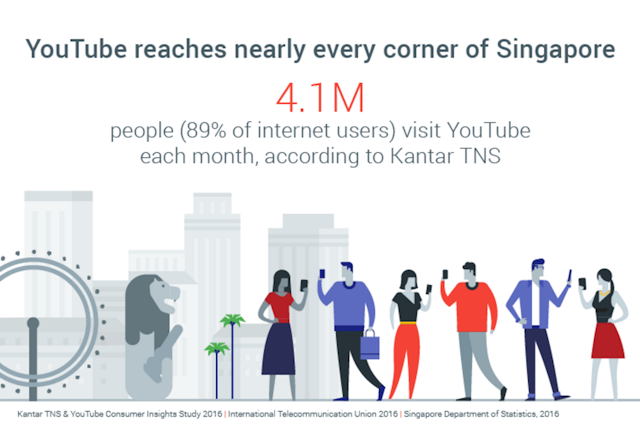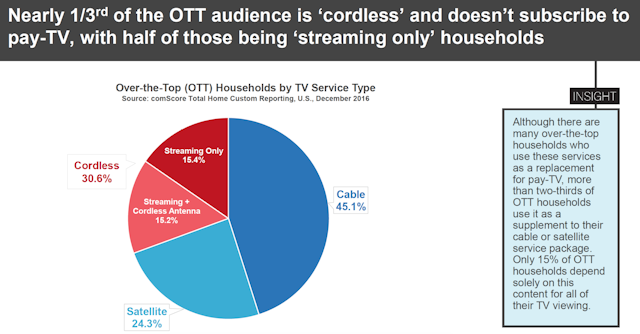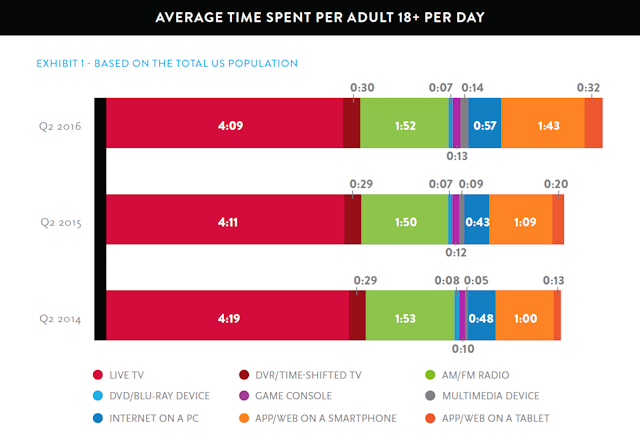TV is not dying – it’s lies, damn lies and bad media statistics
It’s the first rule in propaganda: if you want people to believe a lie, then just repeat it over and over again.

For some 15 years, marketers have been subjected to constant reports that commercial TV will soon 'die'. They started by blaming TiVo and commercial skipping before moving to cord-cutting millennials who prefer Netflix and then citing the reported swing today of advertising dollars from offline to online. Call me crazy, but ad-supported television still seems to be around. Something does not add up.
In the past few weeks, the industry has seen yet another flood of breathless, urgent warnings and allegedly important studies. Here are just a few:
● An AdAge column by The Palmer Group chief executive Shelly Palmer argued that “TV may actually die soon”.
● ReFUEL4 marketing manager Alexis Ng wrote in a column in The Drum that “the death of traditional advertising is real”.
● A report from Google found that younger Singaporeans prefer YouTube to television as the online video platform itself plans to produce.
Please excuse the hard-boiled exterior that I still have as a journalist who later went into marketing: for people who are also supposed to be cynics, marketers are surprisingly susceptible to believing bad data and people with conflicts of interest.
Palmer’s agency focuses on “augmented intelligence and data-driven decision making” – and not on television. Moreover, his column made assertions without offering any proof. Writing an opinion column without supporting evidence is as useful as Kendall Jenner giving a Pepsi to police officers in riot gear.
Ng’s company sells social media advertisements that are purportedly designed by human beings and automated with artificial intelligence. The business has an interest in casting a shadow on television as a useful medium. If a company that sells widgets argues that not-widgets are bad, I am always skeptical.
Please also excuse my eye-rolling when the company that owns YouTube puts out a study stating that YouTube is preferred over TV. The report and accompanying press release do not explain the study's specific methodology – and that's where things always get dodgy.

(Free journalism advice: always follow the money to see who is really in charge, look at the fine print of any business deal, and read the methodology of any study. And wear sunscreen.)
Google’s data point: “89% of internet users visit YouTube each month.” Well, I want to know what 'visit' means. Does it include anyone who watched even one second of one video one time per month? If so, then that percentage looks a lot less impressive.
One of the biggest falsehoods in the marketing echo chamber is that television is 'dead' – and that lie is usually spread by companies with something to gain or people who do not bother to research what the good data actually says. People keep repeating the propaganda over and over again.
Here’s the data
It’s time to fix the promotion mix by forgetting the half-baked opinions and biased analyses on the state of television and seeing what the true, impartial statistics from neutral sources truly report.
comScore
According to comScore’s latest comprehensive report on the use of various TV platforms in the United States:

● Live TV consists of 84% of total TV viewing time.

● Only 15% of households are “streaming only.” Most who use streaming services do so as a supplement to traditional TV.

● For every hour that is viewed on streaming services, people watch more than five hours of live television.

● Live TV still dominates, even among the heaviest users of streaming television
Nielsen
Here is the Nielsen data specifically from the most recent Total Audience Report in the United States:

● People spend the majority of this time watching live television and listening to AM/FM radio
Thinkbox
Here is some Thinkbox 2016 UK data that is compiled from the Broadcasters’ Audience Research Board (BARB), comScore, the IPA’s Touchpoints 2016 study, Ofcom’s 2016 Digital Day study, and Rentrak box office data.

● The majority of video was viewed as live TV

● 86% of video ad spend was on live television

● Thinkbox also found that TV viewing has remained level despite the rise of social media, mobile and streaming over the past decade. There has been a decline of four minutes of television watching per day since 2006
Last but not least, here are a few other data points:
● Deloitte recently found that subscriptions to paid television services in the US have remained relatively stable since 2012 and “cord-cutting” is not really occurring.
● In the UK, only 2% of millennials want to watch sport as clips on social media networks – the preferred method is live TV.
● People in the US still spend the vast majority of their leisure time watching television (as compared to using other media).
Now, tell me if you can read ShareThis chief executive Kurt Abrahamson’s Adweek opinion piece “Social Media is the New Television” with a straight face.
The 'false consensus effect'
TV will not 'die'. Anyone who says differently is selling something.
The marketing industry has its own 'fake news' problem. Too many marketers – especially in digital marketing – accept what is said in our industry's echo chamber without thinking critically or asking for evidence.
As Jason Miller wrote in a column for The Drum, that very issue was discussed during a panel at Advertising Week Europe. (Spoiler: a lot of marketing adages that you probably believe are completely and utterly wrong.)
Why do so many digital marketers think that television is dying despite all of the easily accessible information that says otherwise? It comes down to the false consensus effect that is created by the biases of the most popular information sources as well as the mistaken assumption that customers are just like marketers.
Many of the most-read sources on digital marketing are the blogs of for-profit companies – and those publications exist to fulfill a business function. Those specific businesses sell marketing software and services to startups and smaller-sized companies, so the blogs will discuss only the tactics that those small organisations can use. Television is ignored because it is not a medium off of which those software- and service-selling companies can make money.
Imagine that you work for eight hours every day on, say, social media for your company. Everything you read is about social media. Every conference you attend discusses social media. You would have tunnel vision and subconsciously think that social media is the only medium that matters. (Substitute any digital marketing activity of choice or even online channels as a whole.)
TV and other traditional channels would be the furthest things from your mind – and you will start to assume that everyone else thinks and acts the same way.
Well, I have some bad news: you are not normal. Too many digital marketers live in a self-reinforcing bubble and work in an echo chamber that consists of about 20% of the marketing world. More on that soon.
When I give presentations as a keynote marketing speaker and write The Promotion Fix column here at The Drum, I often talk about traditional marketing with digital marketers and about digital marketing with traditional marketers. I do it because we need to break down the silos between 'traditional' and 'online' marketing.
We are all doing marketing – and we are all simply doing it over various online and digital mediums in the process. We can do activities such as brand advertising, public relations and direct marketing over traditional or online channels. We should not be 'digital-first' or 'offline-first'. We should use the best media mix for each given objective.
If the only marketing tool that you have is a hammer, then every marketing problem looks like a nail. We’re gonna need a bigger toolbox. We need to be channel-neutral and open to all types of mediums when we create strategies for our promotion mixes.
My point here is not to advocate for television – I have no 'skin' in this marketing game. My purpose is to highlight that TV can be valuable. One common argument against television is that it is expensive, but cheap marketing tactics all too often result in crap such as floods of useless 'content marketing'.
You are not the customer
Based on what I have seen in the online marketing industry, I will make an informed guess that the average digital marketer is under the age of 35, does not have children, works and probably lives in a city, has a university or graduate degree, goes out with friends multiple nights every week, has an easy commute and does not own a car, votes on center-left side of the spectrum, spends hours on Twitter, brags about not having a television, and binges Orange is the New Black on Netflix.
Let me repeat the bad news: you are not normal.
Take a look at these additional findings from Thinkbox:

Many of the people who purchase our products are in their forties and fifties and have several children. They live in Kansas or East Lindsey. They never went to university. They spend an hour each way commuting to and from suburbia to a menial, low-tech job at which they are overworked and underpaid. They come home to a dinner of leftovers because the spouse wanted to save money and pay some overdue bills. They have disagreeable teenagers who just want to go out and do who-knows-what with who-knows-who. Many of them voted for Donald Trump and Brexit. They have tweeted maybe once or twice at most.
And you know what? They are tired. After they return from work and eat the reheated casserole from yesterday, they just want to relax, sit on the couch, and drink some beer or wine. They want to turn off their brains, watch television, and be entertained by that large box in the living room until they fall asleep.
Same as it ever was. Marketers have a distorted view of the average person’s actual media consumption.
Why TV Works
As The Drum reported on a recent study from the Video Advertising Bureau:
“...the average American spends far more time watching live TV and far less time online than advertisers think and suggests that the advertisers and marketers themselves too often assume that the viewing habits are more akin to their own. In other words, marketers and advertisers, who tend to be younger, more affluent urban professionals have not taken into consideration their own average age, tastes, and lifestyle while their target viewers are in fact sticking with live television, and view video and TV online far less often than assumed.”
I’m not yet a middle-aged man with children, but I am also tired when I get home from work. When I want to relax, I watch TV or go to the movies. When I go online, it’s because I am trying to get something done (or I'm playing Civilisation). I actively avoid 'brand experiences' online partly because of the targeting and tracking that may lead to the downfall of the adtech and martech industries.
And I’m not the only one. A report from the IBM Institute for Business Value found that most people are disappointed with digital brand experiences. We often watch television commercials but seize every opportunity to block online advertisements.
Why? As Jakob Nielsen wrote about online ads in 1997, TV is warm and the internet is cold. 20 years later, the data still proves his point:

In the end, the internet is dry and informative but television is magical and entertaining. Guess which one is better at planting seeds and building brands over mass audiences?
While I was speaking at the online marketing conference MozCon in Seattle last year, I saw digital evangelist Sarah Weise introduce some of the marketing principles in cognitive psychology – namely, that human beings typically make decisions with the emotional part of our brains and then justify the choices later with the rational part in our frontal lobes:

That’s the power of television: it’s a medium that taps into the emotional part of our brains much more easily than online channels. It’s little wonder that traditional mediums such as TV and print are more also trusted than digital ones.
Reports of TV’s death have been greatly exaggerated. Just ask Taco Bell chief marketing officer Marisa Thalberg, who plans to spend less on digital channels and more on television. It seems that more will join her.
The Promotion Fix is a new, exclusive biweekly column for The Drum contributed by Samuel Scott, director of marketing and communications for AI-powered log analysis software platform Logz.io and a global marketing speaker on integrated traditional and digital marketing. Follow him on Twitter and Facebook. Scott is based out of Tel Aviv, Israel.

